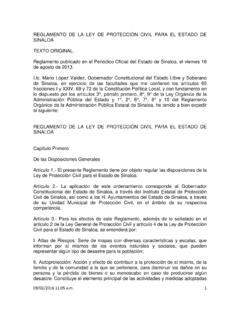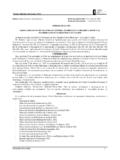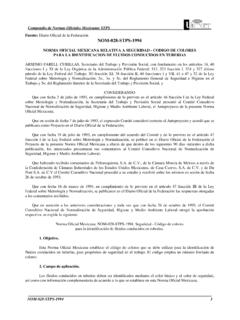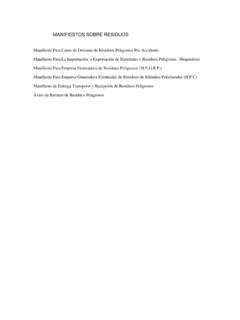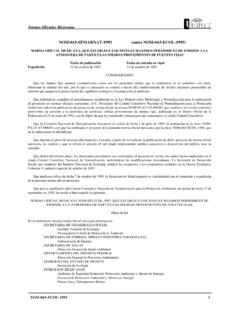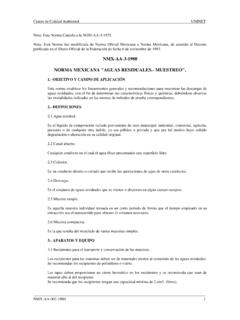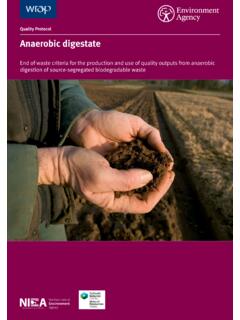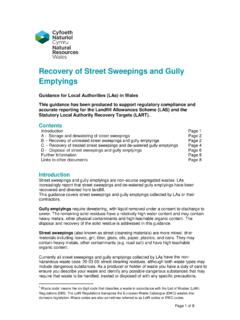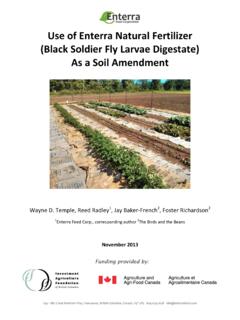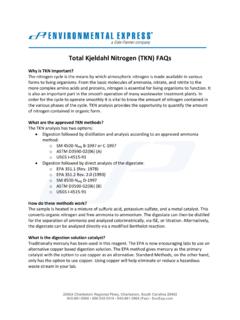Transcription of METHOD 3050A ACID DIGESTION OF SEDIMENTS, …
1 CD-ROM3050A - 1 Revision 1 July 1992 METHOD 3050 AACID DIGESTION OF SEDIMENTS, SLUDGES, AND AND This METHOD is an acid DIGESTION procedure used to prepare SEDIMENTS, sludges, and soil samples for analysis by flame or furnace atomic absorptionspectroscopy (FLAA and GFAA, respectively) or by inductively coupled argon plasmaspectroscopy (ICP). Samples prepared by this METHOD may be analyzed by ICP forall the listed metals, or by FLAA or GFAA as indicated below (see also Step ): FLAA GFAAA luminumMagnesiumArsenicBariumManganeseBe rylliumBerylliumMolybdenumCadmiumCadmium NickelChromiumCalciumOsmiumCobaltChromiu mPotassiumIronCobaltSilverLeadCopperSodi umMolybdenumIronThalliumSeleniumLeadVana diumThalliumZincVanadiumNOTE.
2 See METHOD 7760 for FLAA preparation for SUMMARY OF A representative 1- to 2-g (wet weight) sample is digested in nitricacid and hydrogen peroxide. The digestate is then refluxed with either nitricacid or hydrochloric acid . Hydrochloric acid is used for flame AA and ICPanalyses and nitric acid is used for furnace AA work. Dilute hydrochloric acidis used as the final reflux acid for (1) the ICP analysis of As and Se, and (2)the flame AA or ICP analysis of Ag, Al, Ba, Be, Ca, Cd, Co, Cr, Cu, Fe, K, Mg,Mn, Mo, Na, Ni, Os, Pb, Tl, V, and Zn.
3 Dilute nitric acid is employed as thefinal dilution acid for the furnace AA analysis of As, Be, Cd, Cr, Co, Fe, Pb,Mo, Se, Tl, and V. The diluted samples have an approximate acid concentrationof (v/v). A separate sample shall be dried for a total % sludge samples can contain diverse matrix types, each of which maypresent its own analytical challenge. Spiked samples and any relevant standardreference material should be processed to aid in determining whether METHOD 3050is applicable to a given - 2 Revision 1 July APPARATUS AND MATERIALS Conical Phillips beakers - 250-mL, or Watch glasses ribbed or Drying ovens - That can be maintained at 30 Thermometer - That covers range of Filter paper - Whatman No.
4 41 or equivalent. Centrifuge and centrifuge Balance - Capable of accurately weighing to the nearest Hot Plate or equivalent - Adjustable and capable ofmaintaining a temperature of 90-95C. Funnel or Graduated cylinder or equivalent. Reagent grade chemicals shall be used in all tests. Unless otherwiseindicated, it is intended that all reagents shall conform to the specificationsof the Committee on Analytical Reagents of the American Chemical Society, wheresuch specifications are available. Other grades may be used, provided it is firstascertained that the reagent is of sufficiently high purity to permit its usewithout lessening the accuracy of the determination.
5 If the purity of a reagentis questionable, analyze the reagent to determine the level of impurities. Thereagent blank must be less than the MDL in order to be Water. Reagent water will be interference free. Allreferences to water in the METHOD refer to reagent water unless otherwisespecified. Refer to Chapter One for a definition of reagent Nitric acid (concentrated), HNO. acid should be analyzed to3determine level of impurities. If METHOD blank is < MDL, the acid can be used. Hydrochloric acid (concentrated), HCl.
6 acid should be analyzed todetermine level of impurities. If METHOD blank is < MDL, the acid can be Hydrogen peroxide (30%), HO. Oxidant should be analyzed to22determine level of - 3 Revision 1 July SAMPLE COLLECTION, PRESERVATION, AND All samples must have been collected using a sampling plan thataddresses the considerations discussed in Chapter Nine of this manual. All sample containers must be prewashed with detergents, acids, andwater.
7 Plastic and glass containers are both suitable. See Chapter Three, , for further Nonaqueous samples shall be refrigerated upon receipt and analyzedas soon as Mix the sample thoroughly to achieve homogeneity. For each digestionprocedure, weigh to the nearest g and transfer to a conical beaker of sample. For samples with low percent solids a larger sample size may beused as long as DIGESTION is Add 10 mL of 1:1 HNO, mix the slurry, and cover with a watch the sample to 95C and reflux for 10 to 15 minutes without boiling.
8 Allowothe sample to cool, add 5 mL of concentrated HNO, replace the watch glass, and3reflux for 30 minutes. Repeat this last step to ensure complete a ribbed watch glass, allow the solution to evaporate to 5 mL withoutboiling, while maintaining a covering of solution over the bottom of the After Step has been completed and the sample has cooled, add 2 mLof water and 3 mL of 30% HO. Cover the beaker with a watch glass and return22the covered beaker to the hot plate for warming and to start the peroxidereaction.
9 Care must be taken to ensure that losses do not occur due toexcessively vigorous effervescence. Heat until effervescence subsides and coolthe beaker. Continue to add 30% HO in 1-mL aliquots with warming until the22effervescence is minimal or until the general sample appearance is :Do not add more than a total of 10 mL 30% If the sample is being prepared for (a) the ICP analysis of As andSe, or (b) the flame AA or ICP analysis of Ag, Al, Ba, Be, Ca, Cd, Co, Cr, Cu,Fe, K, Mg, Mn, Mo, Na, Ni, Os, Pb, Tl, V, and Zn, then add 5 mL of concentratedHCl and 10 mL of water, return the covered beaker to the hot plate, and refluxfor an additional 15 minutes without boiling.
10 After cooling, dilute to a 100 mLvolume with water. Particulates in the digestate that may clog the nebulizershould be removed by filtration, by centrifugation, or by allowing the sample tosettle. Filtration - Filter through Whatman No. 41 filter paper (orequivalent). CD-ROM3050A - 4 Revision 1 July Centrifugation - Centrifugation at 2,000-3,000 rpm for10 minutes is usually sufficient to clear the The diluted sample has an approximate acid concentration (v/v) HCl and (v/v) HNO.
